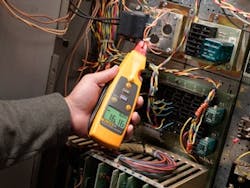Steel mill cuts emissions through instrument calibration
Robert Applegate feels compelled to stay current with process control technology, especially when it might have a direct effect on controlling acid rain and other pollutants. As manager of Applegate Automation Enterprises LLC, New Cumberland, W.Va., 20 weeks of his work year are devoted to consulting on a high-pressure boiler emission-monitoring system at a steel mill in the Northeast.
At the mill, critical readings about system operations are taken from field instruments connected via 4-20 mA loops to a distributed control system (DCS). Additional DCS loops send control information to the emission-monitoring system, enabling the mill to verify continued compliance with EPA-mandated requirements. The DCS data, also used for proper/safe boiler operation, aren’t available for troubleshooting or calibration during operation.
The mill has five major boilers whose outputs feed into stacks. The emission-monitoring system extracts continuous stack samples, measuring the nitrous oxide and oxygen concentrations. Controlling the NOx and sulfur dioxide allows the mill to reduce emissions of nitric acid and sulfuric acid.
“We look at the fuels that flow into the boiler, the monitoring instruments that report the fuel flow rates,” Applegate says. “Then we take those rates, combine them with the amount of heat present in that fuel, and generate the heat input. Now we have a heat input and a steam flow out of the boiler, and we have the concentration in the stack. From those three measurements, we develop what we call the emission factor.” The emission factor determines how much NOx went up the stack under that set of circumstances.
Applegate points to the critical need for noninvasive testing. “The instruments reporting fuel flows also control the boiler, and they have to be calibrated,” he says. “I can’t go out there and say, ‘I’ll just disconnect the oil flow meter and measure the flow.’ If I did that, the boiler would trip.”
At one time, he says, the only way to troubleshoot those instruments was to shut the boilers down, which meant waiting for once- or twice-yearly planned outages. “That meant there were long periods when I couldn’t verify what a process control instrument was actually doing — unless I had a tool like the Fluke 771. Now I can go out there and measure the circuit loop between the instrument and the DCS, and say ‘All right, I’m at 55%.’ Now I look at what’s coming to the NOx system and verify that it’s also 55%. You can compare the input side to the output side without disconnecting anything.”
In the DCS world, readings of all kinds are converted from current readings between 4 mA and 20 mA to a percent of some value. Working directly with percentages is often easier than translating current values. A unique feature of the Fluke 771 is its dual readings: milliamps and percent of scale. For example, “A reading of 4 mA equates to 0% of scale, and a reading of 20 mA equates to 100%,” Applegate says. “In my case, 55% would give me a reading of 12.8 mA.”
The jaws on the Fluke 771 detach from the meter’s body for measurement in tight spaces, while allowing the user to read the screen in a less cramped or better-lit area. The 771 also features a built-in measurement spotlight to illuminate hard-to-see wires in tight locations or dark enclosures.
“What I like about the Fluke 771 is that it’s uncomplicated,” Applegate says. “It’s not huge or unwieldy, and it’s straightforward to use. A 4-20 mA tester like the Fluke 771 is the kind of tool that everybody in the process control world needs to do this type of work effectively. It’s going to be like a flashlight.”
